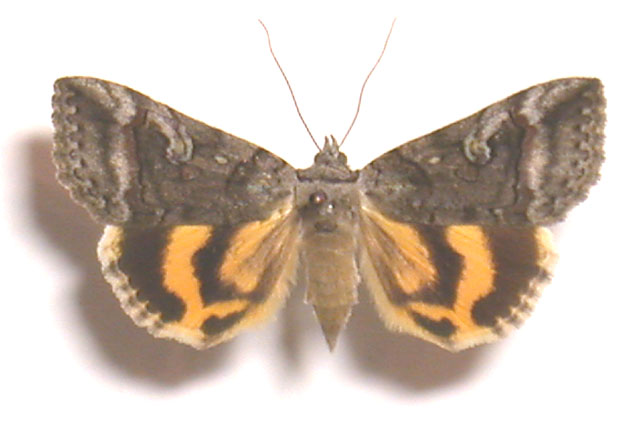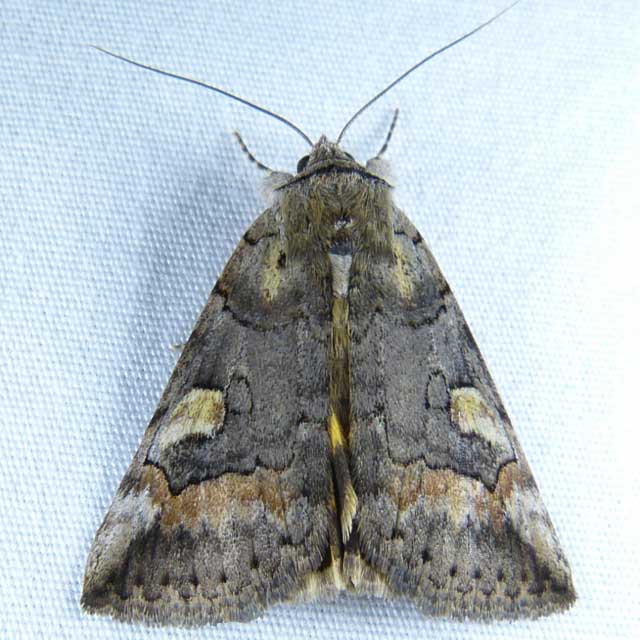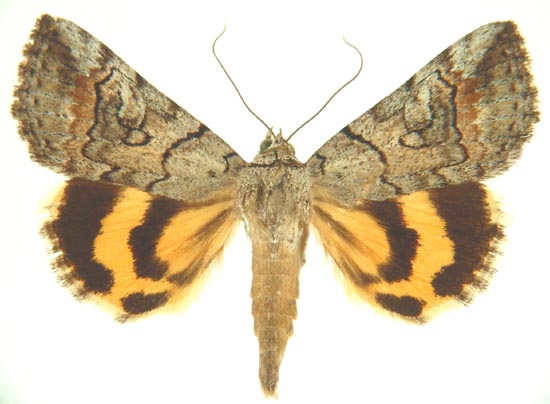Catocala similis
Catocala similis
kah-TOCK-uh-lah
mmSIM-ih-lis
Edwards, 1864

Catocala similis courtesy of Lynn Scott.
This site has been created by
Bill Oehlke at oehlkew@islandtelecom.com
Comments, suggestions and/or additional information are welcomed by Bill.
| TAXONOMY:
Superfamily: Noctuoidea
Family: Noctuidae
Group: Noctuinina
Subfamily: Catocalinae
Genus: Catocala, Schrank, 1802
| |
MIDI MUSIC
"Moon River"
copyright C. Odenkirk
MIDI CITYON.OFF
<bgsound src="moon.mid" LOOP=FOREVER>
|
DISTRIBUTION: Catocala similis, the Similar
Underwing (wingspan: 35-45mm), flies from
Ontario and
Quebec south
through Maine and Connecticut
to Florida, west to Texas and
Oklahoma and north to Minnesota.
The pale triangular patch from the postmedial line along the costa,
pointed at the apex, and the light-coloured, tear-shaped reniform
spot distinguish this species. Tim Dyson photo. The subreniform
spot also projects considerably beyond the
reniform anteriorally at a right angle to the line of the subreniform.
|  |
It has also been recorded in
Alabama,
Arkansas,
Georgia,
Illinois,
Indiana,
Kansas,
Kentucky,
Louisiana,
Massachusetts,
Maryland,
Michigan,
Missouri,
Mississippi,
North Carolina,
New Hampshire,
New Jersey,
New York,
Ohio,
Pennsylvania,
Rhode Island,
South Carolina,
Tennessee,
Virginia,
Wisconsin and
West Virginia.
Many specimens also have a small, light coloured, flattened oval spot about halfway between the pm and am lines at about the
midpoint of the reniform spot. The pm line is almost straight for most of its length.

Catocala similis courtesy of Pierre Legault.
FLIGHT TIMES AND PREFERRED FOOD PLANTS:
Catocala similis are usually on the wing from May in Texas
and Alabama (DB: May 11), and from June to July in most other areas.
The Catocala similis caterpillar feeds primarily on oaks.
ECLOSION:
Adults eclose from pupae at soil surface.

Catocala similis, Buffalo County, Wisconsin,
July 16, 2014, courtesy of Marcie O'Connor.
SCENTING AND MATING:
Catocala similis females
emit an airbourne pheromone and males use their antennae to track the
scent plume.
EGGS, CATERPILLARS, COCOONS, AND PUPAE:
Eggs are deposited on
tree bark in the fall and hatch the following spring.
Larval Food Plants
Listed below are primary food plant(s) and alternate food plants.
It is hoped that this alphabetical listing followed by the common
name of the foodplant will prove useful. The list is not exhaustive,
although some species seem very host specific.
Experimenting with closely related foodplants is worthwhile.
Carya illinoinensis.....
Quercus stellata
|
Pecan
Post oak
|

Use your browser "Back button to return to the previous page.
Goto Main Catocala Index
This page is brought to you by Bill Oehlke and the
WLSS. Pages are on space rented from Bizland. If you would like to become a "Patron of the Sphingidae/Catocala Sites",
contact Bill.
Please send sightings/images to Bill. I will do my best to respond to requests for identification help.
Enjoy one of nature's wonderments: Live Saturniidae (Giant Silkmoth) cocoons.

|

To show appreciation for this site, click on the flashing
butterfly to the left, a link to many worldwide insect sites. |






